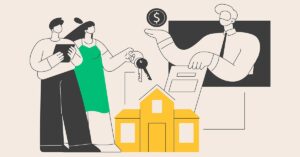Nonqualified mortgages have taken off in 2019. These unconventional loans, which don’t meet the criteria to be backed by Fannie Mae or Freddie Mac, are seeing a wave of growth due to an expansion of products and guidelines.
To get an idea of the growth, consider this: about $10 billion of these loans, commonly called non-QM, were securitized during the first half of this year, according to S&P Global Ratings. That’s about double the tally for the same period last year.
Unfortunately, many originators and borrowers view these loans as just a new name for subprime loans. While low credit-score or high debt-to-income products are a portion of the programs available, there has been an increase in the diversity of programs and borrowers. Some examples of the new non-QM loan opportunities include:
Self-employed borrowers, who may have complex and diversified income streams
Foreign-national borrowers, who have no credit history in the U.S., and may have trouble qualifying for conventional programs, despite significant assets for a downpayment
Borrowers with significant assets, who can have trouble documenting their income, which makes conventional loans difficult to obtain
Many originators may be surprised by how non-QM loans can be structured responsibly while taking into account an ability to repay with competent underwriting.
Identify opportunities
Anyone who has been in this business for a while has seen the great credit borrower who is a little different. They do not fit the Fannie or Freddie underwriting box, yet when examining their entire financial story, they look like a dependable borrower.
In fact, they are just missing Fannie or Freddie guidelines. Originators need to be aware of the alternative loan programs that they can provide these clients. In addition to “saving the deal” by providing a solution, these types of borrowers are likely to recommend the originator to similar borrowers, resulting in more loans down the road.
You can identify these non-QM borrowers immediately by answering a few simple questions. Are they a business owner without a W-2 or tax records for their business? Are they a borrower with gaps in their income, but are “asset rich” with property, investments, retirement accounts and cash on hand? Are they an investor who has their income and assets tied up in their property?
These borrowers may be a non-U.S. citizen with a visa and, potentially, previous U.S. work history. It may not matter if they have U.S. credit as long as they have a foreign-credit history. Do they have a credit score of 620 or above? Is it an individual with no visa or green card who files their taxes with an individual tax identification number (ITIN)? When documented correctly, these types of borrowers may be better credit risks than borrowers of government-backed loan programs that encourage low credit scores, as well as high loan-to-value and debt-to-income ratios.
Originators who are not considering their conventional loan fallout alternatives and potential second-chance options may find it challenging to earn as much as they did in the past when interest rates rise. Refinance activity won’t go on forever. The smart mortgage brokers and loan officers understand this and seek to optimize their marketing expenditures by having more alternatives for the folks knocking on their door for a loan.
“ Originators who create great relationships now with non-QM lenders will continue to prosper and grow in the coming months. ”
Distinct differences
Originators need to be aware that not all non-QM loans are created equal. Some put a strong focus on high-quality service, which can be helpful to the originator who is used to using an automated underwriting engine, such as Fannie Mae’s Desktop Underwriter or Freddie Mac’s Loan Prospector.
The non-QM space is more “high touch” than “high tech,” so some of the lender participants recognize the need to help originators through the process. Some focus on unique programs and others try to lead with price.
Generally speaking, most lenders offer bank-statement programs (12 and 24 months), but some offer shorter time frames, such as one- to six-month programs with other documentation and a reliance on loan-to-value ratios and credit scores. Asset-depletion programs, which calculate monthly income by dividing a borrower’s total assets by a set number of months, may use a lower percentage of assets toward income than privately sourced programs.
Most originators are aware of the standard 120-month divisor that can make qualifying difficult. Some privately funded asset-depletion programs use a 60-month divisor, potentially doubling the borrower’s qualifying income. This can be the difference between an originator saying, “No, I’m sorry,” or returning to their client with a “yes” answer.
Dynamic market
Today’s mortgage environment is dynamic and moves quickly. Interest rates have had larger swings in the past 12 months than in the previous seven years.
Non-QM has moved from being a low-credit alternative for Federal Housing Administration loans to an excellent alternative for creditworthy borrowers. That’s especially true when you think of the growing number of borrowers who could use these loans, including 5.6 million business owners and an aging population of retirees with many assets. A good non-QM program can offer competitive rates and loan options that will meet their unique needs.
Originators who create great relationships now with non-QM lenders will continue to prosper and grow in the coming months. Originators should be quickly identifying borrowers who could fall into this segment and warming them to the idea of non-QM if they just miss conventional standards. Better yet, they should proactively advise these clients to apply for the best loan, so they save time and money.
Finding the best partner for your company in the non-QM space will require a little research, time and realignment of how one thinks about this type of lending. Lenders that offer an excellent menu of products and that actually deliver on high-quality support can be beneficial to an originator. Partnering with such a lender can enable the originator to continue to produce strong loan volumes, despite what may be happening with interest rates and their effects on conventional volumes.
Drive volume
The non-QM market continues to look favorable for the rest of 2019. Loan programs that have entered the space as solutions for many types of borrowers are not the same subprime loans from 2006. They use common-sense under-writing, complete documentation and good-to-excellent credit scores.
There are still many disenfranchised borrowers out there. The more that originators learn about these products, the more that will drive volume within the non-QM space.
The market itself is underserved. Originators who have seen their volume drop, and who turn away one-third to one-half of their conventional leads because they don’t meet conventional underwriting guidelines, need to start expanding their relationships with non-QM lenders. By doing this, it will help them remonetize their leads and provide a broader set of loan solutions.
Author
-

Joseph Lydon is co-founder and co-managing director at LendSure Mortgage Corp. He has spent more than three decades in the mortgage industry, including serving as president and chief operating officer at Accredited Home Lenders from 1997 to 2008. He has also worked at Ford Consumer Finance and Security Pacific Financial Services. Lydon earned a bachelor’s degree in management from Pepperdine University and a master’s degree from the University of San Diego.
View all posts







